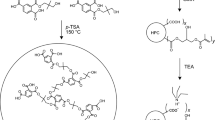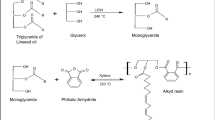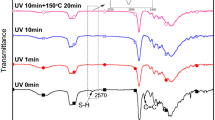Abstract
Polyethylene terephthalate (PET) films have been widely applied in the display industry. However, there is a problem in effectively protecting and extending the service life. To address this issue, a hyperbranched polyurethane acrylate (HPUA) has been synthesized with poly (hexylene glycol) neopentyl glycol ester (PNA), isophorone diisocyanate (IPDI), hyperbranched polyol Boltorn™H2004 and pentaerythritol triacrylate (PETA). Further, a series of high-performance UV curable coatings have been prepared with HPUA, hollow nano-SiO2 and silane coupling agents, along with other reagents. The structure of HPUA has been characterized by infrared spectroscopy (FT-IR), and the curing process has been monitored kinetically by real-time infrared spectroscopy to study its double-bond conversion ratio. The properties of the cured films have been investigated by thermogravimetric analysis (TGA). The water contact angle, aging and yellowing resistance, hardness, flexibility, abrasion resistance, light transmittance, and adhesion of the cured coatings on PET film have been tested. The results have shown that the addition of hollow nano-SiO2 and silane coupling agents has not only not affect the light transmittance of the coatings but also improved the surface properties and heat resistance. When the silane coupling agent has been γ-Methacryloxypropyltrimethoxysilane (KH-570), the water contact angle of the coating has been 101.8°, excellent resistance to aging and yellowing, and the hardness, flexibility, and abrasion resistance have reached 89.4 HD, 3 mm, and 500 g/350 times, respectively. It was worth mentioning that the cured coating has shown excellent adhesion to PET film with the best overall performance. This work has offered important guidance for the protection of PET films.






Similar content being viewed by others
Data availability
Data will be made available on request.
References
Jiao Z, Yang Q, Wang X et al (2017) UV-curable hyperbranched urethane acrylate oligomers modified with different fatty acids. Polym Bull 74:5049–5063
Liu C, Li T, Zhang J et al (2016) Preparation and properties of phosphorous-nitrogen containing UV-curable polymeric coatings based on thiol-ene click reaction. Prog Org Coat 90:21–27
Sagong H, Seo H, Kim T et al (2020) Decomposition of the PET film by MHETase using Exo-PETase function. ACS Catal 10(8):4805–4812
Szczurek A, Tran T, Kubacki J et al (2023) Polyethylene terephthalate (PET) optical properties deterioration induced by temperature and protective effect of organically modified SiO2–TiO2 coating. Mater Chem Phys 306:128016
Chang C, Oyang T, Hwang F et al (2012) Preparation of polymer/silica hybrid hard coatings with enhanced hydrophobicity on plastic substrates. J Non Cryst Solids 358:72–76
Xu J, Pang W, Shi W (2006) Synthesis of UV-curable organic-inorganic hybrid urethane acrylates and properties of cured films. Thin Solid Films 514:69–75
Miao X, Li Y, Zhang Q et al (2012) Low shrinkage light curable dental nanocomposites using SiO2 microspheres as fillers. Mater Sci Eng 32(7):2115–2121
Startek K, Szczurek A, Tran T et al (2021) Structural and functional properties of fluorinated silica hybrid barrier layers on flexible polymeric foil. Coatings 11(5):573
Park S, Thanakkasaranee S, Shin H et al (2020) Preparation and characterization of heat-resistant PET/bio-based polyester blends for hot-filled bottles. Polym Test 91:106823
Zhong W, Yang X, Gao H et al (2021) Oxygen barrier property of synthesized polyacrylate coatings containing inter-chain cross-linking architecture on PET film. J Appl Polym 138(33):50836
Qiu F, Xu H, Wang Y et al (2012) Preparation, characterization and properties of UV−curable waterborne polyurethane acrylate/SiO2 coating. J Coat Technol Res 9(5):503–514
Kim J, Cho B, Kweon J et al (2014) Preparation and properties of UV−curable di−functional sulfur−containing thioacrylate and thiourethane acrylate monomers with high refractive indices. Prog Org Coat 77(11):1695–1700
Takeuchi H, Konno T, Mori H (2017) Synthesis of multifunctional silsesquioxane nanoparticles with hydroxyl and polymerizable groups for UV−curable hybrid coating. React Funct Polym 115:43–52
Yong Q, Pang H, Liao B et al (2018) Preparation and Characterization of Low Gloss Aqueous Coating via Forming Self-roughed Surface Based on Waterborne Polyurethane Acrylate Hybrid Emulsion. Prog Org Coat 115:18–26
Lv C, Hu L, Yang Y et al (2015) Waterborne UV-curable polyurethane acrylate/silica nanocomposites for thermochromic coatings. RSC Adv 5:25730–25737
Zhang Q, Huang C, Wang H et al (2016) UV-curable coating crosslinked by a novel hyperbranched polyurethane acrylate with excellent mechanical properties and hardness. RSC Adv 6:107942–107950
Wang Q, Thomas J, Soucek M (2023) Investigation of UV-curable alkyd coating properties. J Coat Technol Res 20(2):545–557
Mao H, Qiang S, Xu Y et al (2017) Synthesis of polymeric dyes based on UV curable multifunctional waterborne polyurethane for textile coating. New J Chem 41(2):619–627
Yin W, Zeng X, Li H et al (2011) Synthesis, photopolymerization kinetics, and thermal properties of UV-curable waterborne hyperbranched polyurethane acrylate dispersions. J Coat Technol Res 8:577–584
Lin R, Yin X, Liu H et al (2023) Synthesis of xylitol-based hyperbranched polyurethane acrylate and its application in self-matting acrylate coatings. J Coat Technol Res 20:1579–1594
Mishra R, Mishra A, Raju K (2009) Synthesis and property study of UV-curable hyperbranched polyurethane acrylate/ZnO hybrid coatings. Eur Polym J 45:960–966
Yang Z, Wicks D, Hoyle C et al (2009) Newly UV-curable polyurethane coatings prepared by multifunctional thiol- and ene-terminated polyurethane aqueous dispersions mixtures: preparation and characterization. Polymer 50:1717–1722
Killops K, Campos L, Hawker C (2008) Robust, efficient, and orthogonal synthesis of dendrimers via thiol-ene “Click” chemistry. J Am Chem Soc 130:5062–5064
Li K, Shen Y, Fei G et al (2015) The effect of PETA/PETTA composite system on the performance of UV curable waterborne polyurethane acrylate. J Appl Polym 132:41262
Wang Y, Wang S, Zhou X et al (2022) A highly stretchable and self-healable hyperbranched polyurethane elastomer with excellent adhesion. React Funct Polym 181:105443
Fu J, Yu H, Wang L et al (2020) Preparation and properties of UV-curable hyperbranched polyurethane acrylate hard coatings. Prog Org Coat 144:10563
Yang Z, Wu J, Ma G et al (2021) Effect of the particle sizes of silica on the properties of UV-curing matting coatings. J Coat Technol Res 18:183–192
Acknowledgements
We gratefully acknowledge financial support from the Natural Science Foundation of Shanxi Province (No. 20210302123094).
Author information
Authors and Affiliations
Contributions
Kexin Zheng: Investigation, experiment, data curation, writing, modification. Lixia Ling: Supervision, funding acquisition, review & editing. Jianbing Wu: Supervision, funding acquisition, review & editing. Baojun Wang: Funding acquisition.
Corresponding author
Ethics declarations
Competing interest
The authors declare that they have no known competing financial interests or personal relationships that could have appeared to influence the work reported in this paper.
Additional information
Publisher's Note
Springer Nature remains neutral with regard to jurisdictional claims in published maps and institutional affiliations.
Rights and permissions
Springer Nature or its licensor (e.g. a society or other partner) holds exclusive rights to this article under a publishing agreement with the author(s) or other rightsholder(s); author self-archiving of the accepted manuscript version of this article is solely governed by the terms of such publishing agreement and applicable law.
About this article
Cite this article
Zheng, K., Ling, L., Wu, J. et al. Preparation of hyperbranched polyurethane acrylates and their properties in UV curable nano-SiO2 composite coatings for PET optical film. J Polym Res 31, 70 (2024). https://doi.org/10.1007/s10965-024-03922-8
Received:
Accepted:
Published:
DOI: https://doi.org/10.1007/s10965-024-03922-8




